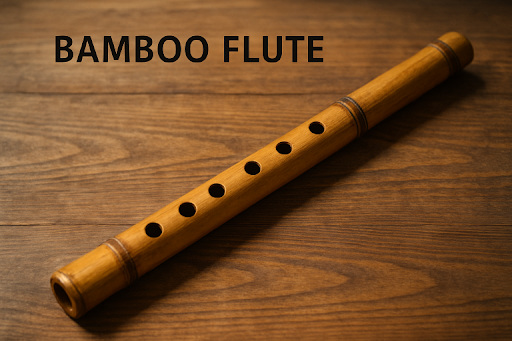Key Takeaways
- Handcrafted bamboo flutes blend traditional craftsmanship with rich cultural heritage.
- Regions like Zijing Village in China and Northeast India are renowned for their bamboo flute industries.
- These instruments are celebrated for their unique tonal qualities and aesthetic appeal.
A Timeless Craft
For centuries, handmade bamboo flutes have inspired musicians and captivated listeners with their distinctive, emotive sound. These instruments, revered in many cultures, embody a close connection between artisan and nature, with every flute reflecting the care, technique, and artistry of its maker. The allure of the bamboo flute lies as much in its ancient heritage as in its resonant, organic tone, which has found favor with both traditional and contemporary artists across the globe. Explorers of wind instruments may quickly encounter the Shakuhachi, a Japanese bamboo flute that exemplifies how regional techniques and aesthetics shape this enduring tradition.
Much of the bamboo flute’s charm is derived from its meticulous handcrafting process, where artisans select and prepare bamboo to enhance sound quality. This attention to detail yields instruments with captivating acoustics and visual appeal, linking musicians to ancient traditions. With growing global appreciation for handicrafts, bamboo flutes symbolize cultural pride, appearing in a variety of music genres beyond folk, including jazz and experimental. The market for these handcrafted instruments thrives, attracting collectors and performers who value their unique qualities, as artisans also adapt to modern trends through workshops and digital outreach.
Global Centers of Bamboo Flute Craftsmanship
In Hangzhou, China, Zijing Village exemplifies the enduring importance of bamboo flutes. By harnessing the abundance of local bamboo and combining traditional techniques with modern business approaches, the village has built a remarkable industry centered around these instruments. In 2023 alone, Zijing Village sold more than 4.5 million bamboo flutes, earning over 350 million yuan and highlighting the economic and cultural impact of this tradition. The interplay between heritage and innovation is key to their continued success.
Northeast India stands out as another world-renowned hub for bamboo flute artistry. Leveraging species of bamboo native to the region, local craftspeople create flutes known for their clarity, warmth, and dynamic range. The fertile alluvial soil and humid climate contribute to ideal growing conditions for bamboo, imparting strong, flexible raw material for instrument making. These flutes have gained international recognition, with exports rising as global musicians seek authentic, hand-finished pieces from India.

The Crafting Process
Every handmade bamboo flute is the result of an intricate, multi-stage process:
- Selection of Bamboo: Artisans choose straight, mature bamboo culms that are free from blemishes and structural flaws, ensuring longevity and clarity of tone.
- Seasoning: The bamboo is carefully dried—a step that can take months—to prevent cracking and stabilize its acoustic properties.
- Shaping and Tuning: The material is cut to the appropriate length, and the bore is polished to a smooth finish. Skilled craftsmen drill and refine finger holes, tuning the flute by subtle adjustments until each note rings true.
- Decoration: Artisans may etch, carve, or paint the bamboo, adding motifs or inscriptions that enhance the instrument’s identity and regional character.
Preserving and Adapting Tradition
The transmission of knowledge is central to the art of bamboo flute craftsmanship. In regions like Yuping Dong Autonomous County, Guizhou, the tradition is a cornerstone of local heritage, with more than two dozen enterprises sustaining techniques passed down from the Ming Dynasty. This continuity ensures that every instrument is not only playable art but also a vessel of centuries-old wisdom.
Cultural Significance
Bamboo flutes hold deep symbolic significance in many cultures, representing purity, harmony, and a connection to the environment. Their music marks ceremonial events, festivals, and rituals—woven into the fabric of community life. In China, India, and beyond, the flute is often associated with spiritual practices and storytelling, serving as a powerful medium for emotional and narrative expression. According to Encyclopedia Britannica, the flute’s importance stretches from religious ceremonies to modern orchestras, testifying to its remarkable adaptability and emotional depth.
Modern Adaptations
Today, bamboo flute making combines evolution with tradition. Artisans around the world incorporate innovative designs, materials, and finishes, adapting to contemporary tastes and expanding their reach through digital channels. The digital age has also democratized access to these instruments, allowing more people to learn about and acquire them via online markets and global shipping. These innovations not only sustain the art form but invite a younger generation of players and makers into a rich musical heritage.
Learning to Play
For those eager to experience the magic of bamboo flutes firsthand, a growing wealth of resources is available—ranging from in-person lessons and workshops to comprehensive digital courses and tutorial videos provided by master artisans. These resources demystify the learning process and invite students to explore not only the technical side of flute playing but also the deeper cultural stories behind each instrument. Engaging with these resources cultivates respect for tradition and for the enduring artistry of bamboo flutes.
Conclusion
The handmade bamboo flute continues to enchant and inspire, bridging past and present with every note. Whether crafted in the serene villages of China or the lush hills of Northeast India, these instruments are distinguished by their harmonious blend of artistry, tradition, and innovation. As artisans and musicians carve out new possibilities, the bamboo flute remains a vibrant testament to the timeless magic of handmade music.



